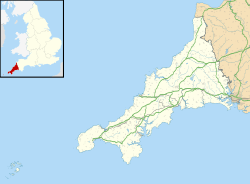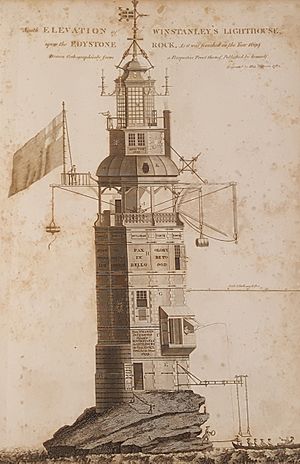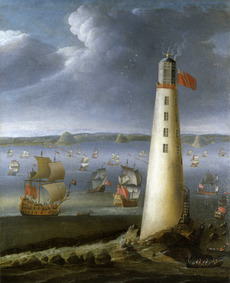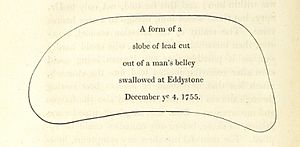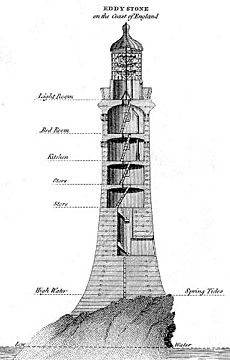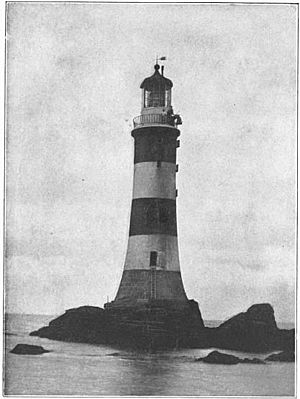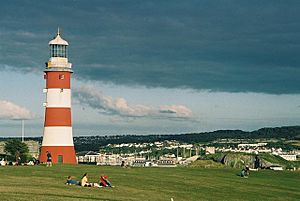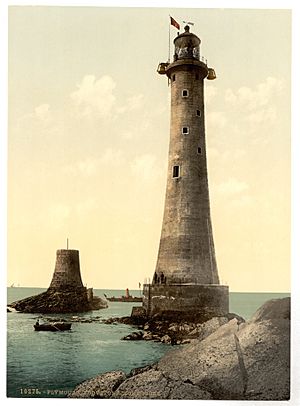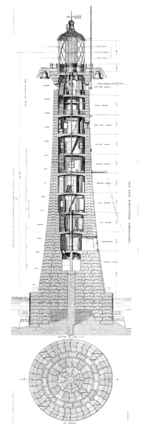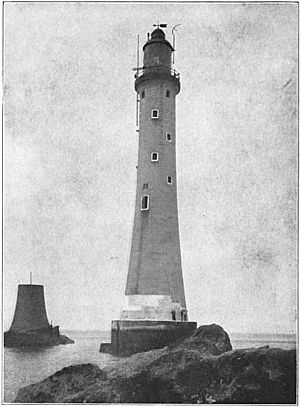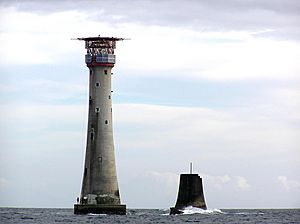Eddystone Lighthouse facts for kids
 |
|
| An aerial view of the fourth lighthouse.
(The stub of the third lighthouse is visible in the background.) |
|
|
|
|
| Location | offshore Rame Head Plymouth England |
|---|---|
| Coordinates | 50°10′48″N 04°15′54″W / 50.18000°N 4.26500°W |
| Year first constructed | 1698 (first) 1709 (second) 1759 (third) |
| Year first lit | 1882 (current) |
| Automated | 1982 |
| Deactivated | 1703 (first) 1755 (second) 1877 (third) |
| Construction | wooden tower (first and second) granite tower (third and current) |
| Tower shape | octagonal tower (first) dodecagonal tower (second) tapered cylindrical tower (third) tapered cylindrical tower with lantern and helipad on the top (current) |
| Height | 18 metres (59 ft) (first) 21 metres (69 ft) (second) 22 metres (72 ft) (third) 49 metres (161 ft) (current) |
| Focal height | 41 metres (135 ft) |
| Current lens | 4th order 250 mm rotating |
| Intensity | 26,200 candela |
| Range | 17 nautical miles (31 km) |
| Characteristic | Fl (2) W 10s. Iso R 10s. at 28 metres (92 ft) focal height |
| Fog signal | one blast every 30s. |
| Admiralty number | A0098 |
| NGA number | 0132 |
| ARLHS number | ENG 039 |
The Eddystone Lighthouse is a lighthouse that is located on the dangerous Eddystone Rocks, 9 statute miles (14 km) south of Rame Head in England. While Rame Head is in Cornwall, the rocks are submerged below the surface of the sea and composed of Precambrian gneiss.
The current structure is the fourth to be built on the site (or arguably the fifth, since the first lighthouse had to be substantially rebuilt after only a year due to harsh conditions). The first lighthouse (Winstanley's) was swept away in a powerful storm, killing its architect and five other men in the process. The second (Rudyard's) stood for fifty years before it burned down. The third (Smeaton's) is the best known, renowned because of its influence on lighthouse design and its importance in the development of concrete for building; its upper portions were re-erected in Plymouth as a monument. The first lighthouse, completed in 1699, was the world's first open ocean lighthouse, although the Cordouan Lighthouse off the western French coast preceded it as the first offshore lighthouse.
Contents
The need for a light
The Eddystone Rocks are an extensive reef approximately 12 miles (19 km) SSW off Plymouth Sound, one of the most important naval harbours of England, and midway between Lizard Point, Cornwall and Start Point. They are submerged at high spring tides and were so feared by mariners entering the English Channel that they often hugged the coast of France to avoid the danger, which thus resulted not only in shipwrecks locally, but on the rocks of the north coast of France and the Channel Islands. Given the difficulty of gaining a foothold on the rocks particularly in the predominant swell it was a long time before anyone attempted to place any warning on them.
Winstanley's lighthouse
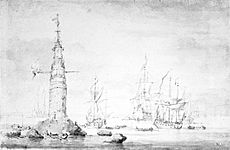
The first lighthouse on Eddystone Rocks was an octagonal wooden structure built by Henry Winstanley. The lighthouse was also the first recorded instance of an offshore lighthouse. Construction started in 1696 and the light was lit on 14 November 1698. During construction, a French privateer took Winstanley prisoner and destroyed the work done so far on the foundations, causing Louis XIV to order Winstanley's release with the words "France is at war with England, not with humanity".
The lighthouse survived its first winter but was in need of repair, and was subsequently changed to a dodecagonal (12 sided) stone clad exterior on a timber framed construction with an octagonal top section as can be seen in the later drawings or paintings. (This gives rise to the claims that there have been five lighthouses on Eddystone Rock.) The octagonal top section (or 'lantern') was 15 ft (4.6 m) high and 11 ft (3.4 m) in diameter, its eight windows each made up of 36 individual glass panes. It was lit by '60 candles at a time, besides a great hanging lamp'.
Winstanley's tower lasted until the Great Storm of 1703 erased almost all trace on 27 November. Winstanley was on the lighthouse, completing additions to the structure. No trace was found of him, or of the other five men in the lighthouse.
The cost of construction and five years' maintenance totalled £7,814 7s.6d, during which time dues totalling £4,721 19s.3d had been collected at one penny per ton from passing vessels.
Rudyard's lighthouse
Following the destruction of the first lighthouse, Captain John Lovett acquired the lease of the rock, and by Act of Parliament was allowed to charge passing ships a toll of one penny per ton. He commissioned John Rudyard (or Rudyerd) to design the new lighthouse.
Rudyard's lighthouse, in contrast to its predecessor, was a smooth conical tower, shaped 'so as to offer the least possible resistance to wind and wave'. It was built on a base of solid wood, formed from layers of timber beams, laid horizontally on seven flat steps which had been cut into the upper face of the sloping rock. On top of this base rose several courses of stone, interspersed with further layers of wood, which was designed to serve as ballast for the tower. This substructure rose to a height of 63 feet (19 m), on top of which were raised four storeys of timber. The entire structure was sheathed in vertical wooden planks and anchored to the reef using thirty-six wrought iron bolts, forged to fit deep dovetailed holes which had been cut in the reef. The vertical planks were installed by two master-shipwrights from Woolwich Dockyard and were caulked like those of a ship. The tower was topped with an octagonal lantern, which brought it to a total height of 92 feet (28 m). A light was first shone from the tower on 28 July 1708 and the work was completed in 1709. The light was provided by 24 candles. Rudyard's lighthouse proved more durable than its predecessor, surviving and serving its purpose on the reef for nearly fifty years.
In 1715 Captain Lovett died and his lease was purchased by Robert Weston, Esq., in company with two others (one of whom was Rudyard).
On the night of 2 December 1755, the top of the lantern caught fire, probably through a spark from one of the candles used to illuminate the light, or else through a fracture in the chimney which passed through the lantern from the stove in the kitchen below. The three keepers threw water upwards from a bucket but were driven onto the rock and were rescued by boat as the tower burnt down. Keeper Henry Hall, who was 94 at the time, died several days later from ingesting molten lead from the lantern roof. A report on this case was submitted to the Royal Society by physician Edward Spry, and the piece of lead is now in the collections of the National Museums of Scotland.
Smeaton's lighthouse
The third lighthouse to be built on the Eddystone marked a major step forward in the design of such structures.
Design and building
Following the destruction of Rudyard's tower, Robert Weston sought advice on rebuilding the lighthouse from the Earl of Macclesfield, then President of the Royal Society. He recommended mathematical instrument maker and aspiring civil engineer, John Smeaton, who was introduced to Weston in February 1756. In May, following a series of visits to the rock, Smeaton proposed that the new lighthouse should be built of stone and modelled on the shape of an oak tree. He appointed Josias Jessop to serve as his general assistant, and established a shore base for the construction works at Millbay.
Work began on the reef in August of 1756, with the gradual cutting away of recesses in the rock which were designed to dovetail in due course with the foundations of the tower. During the winter, the workers stayed ashore and were employed in dressing the stone for the lighthouse; work then resumed on the rock the following June, with the laying of the first courses of stone. The foundations and outside structure were built of local Cornish granite, while lighter Portland limestone masonry was used on the inside. As part of the construction process, Smeaton pioneered 'hydraulic lime', a concrete that cured under water, and developed a technique of securing the blocks using dovetail joints and marble dowels. Work continued over the course of the following two years, and the light was first lit on 16 October 1759.
Smeaton's lighthouse was 59 feet (18 m) high and had a diameter at the base of 26 feet (8 m) and at the top of 17 feet (5 m). It was lit by a chandelier of 24 large tallow candles.
Later modifications
In 1807 the 100-year lease on the lighthouse expired, whereupon ownership and management devolved to Trinity House. In 1810 they replaced the chandelier and candles with 24 Argand lamps and parabolic reflectors.
In 1841 major renovations were made, under the direction of engineer Henry Norris of Messrs. Walker & Burges, including complete repointing, replacement water tanks and filling of a large cavity in the rock close to the foundations. In 1845 the lighthouse was equipped with a new second-order fixed catadioptric optic, manufactured by Henry Lepaute of Paris, with a single multi-wick oil lamp, replacing the old lamps and reflectors. This was the first time that a fully catadioptric large optic (using prisms rather than mirrors above and below the lens) had been constructed, and the first such installation in any lighthouse. A new lantern was constructed and fitted to the top of the tower in 1848, as the original had proved unsatisfactory for housing the new optic.
From 1858 the tower's exterior was painted with broad red and white horizontal bands, so as to render it 'more distinctly visible during the day time'. In 1872 a 5 cwt fog bell was provided for the lighthouse; it was sounded 'five times in quick succession every half minute' in foggy weather.
In 1877 it was resolved to build a replacement lighthouse, following reports that erosion to the rocks under Smeaton's tower was causing it to shake from side to side whenever large waves hit. During construction of the new lighthouse, the Town Council of Plymouth petitioned for Smeaton's tower to be dismantled and rebuilt on Plymouth Hoe, in lieu of a Trinity House daymark which stood there. Trinity House consented to the removal and delivery of the lantern and the upper four rooms of the tower, the cost of labour to be borne by Plymouth Council. While the new tower was being built the old lighthouse remained operational, up until 3 February 1882 (after which a temporary fixed light was shown from the top of the new tower). When the latter was complete, Smeaton's lighthouse was decommissioned and the crane which had been used to build the new lighthouse was transferred to the task of dismantling the old. William Tregarthen Douglass supervised the operation.
Present day
The upper part of Smeaton's lighthouse was subsequently rebuilt, as planned, on top of a replica granite frustum on Plymouth Hoe: preserved 'as a monument to Smeaton's genius, and in commemoration of one of the most successful, useful and instructive works ever accomplished in civil engineering'. The rebuilding was funded by public subscription. It remains in place today and, as 'Smeaton's Tower', is open to the public as a tourist attraction.
The original frustum or base of the tower also survives, standing where it was built on the Eddystone rocks, 120 feet (37 m) from the current lighthouse. Having dismantled the upper part of the structure, Douglass infilled the old entrance way and stairwell within the frustum and fixed an iron mast to the top of the stub tower. He expressed the hope that 'the rock below will for ages endure to support this portion of Smeaton's lighthouse, which, in its thus diminished form, is still rendering important service to the mariner, in giving a distinctive character to the Eddystone by day'.
Douglass's lighthouse
The current, fourth lighthouse was designed by James Douglass (using Robert Stevenson's developments of Smeaton's techniques). This lighthouse is still in use.
Design and building
By July 1878 the new site, on the South Rock was being prepared during the 3½ hours between ebb and flood tide; the foundation stone was laid on 19 August the following year by HRH The Duke of Edinburgh, Master of Trinity House. The supply ship Hercules was based at Oreston, now a suburb of Plymouth; stone was prepared at the Oreston yard and supplied from the works of Messrs Shearer, Smith and Co of Wadebridge. The tower, which is 49 metres (161 ft) high, contains a total of 62,133 cubic feet of granite, weighing 4,668 tons. The last stone was laid on 1 June 1881 and the light was first lit on 18 May 1882.
The lighthouse was topped by a larger than usual lantern storey, 16 ft 6 in (5.03 m) high and 14 ft (4.3 m) wide; the lantern was painted red. It contained a six-sided biform (i.e. two-tier) rotating optic of the first-order, 12 ft 6 in (3.81 m) high and weighing over seven tons. Each of the six sides of the optic was divided into two Fresnel lens panels, which provided the light's characteristic of two flashes every thirty seconds. The optic was manufactured by Chance Brothers of Smethwick and designed by their chief engineer John Hopkinson FRS. At the time the Eddystone's extra-tall (6 ft 3 in (1.91 m)) lenses were the largest in existence; their superior height was achieved through the use of extra-dense flint glass in the upper and lower portions of each panel.
The light had a range of 17 nautical miles (31 km; 20 mi). Illumination was provided by a pair of Douglass-designed six-wick concentric oil burners (one for each tier of the optic). This was said to represent 'the first practical application of superposed lenses of the first order with oil as the illuminating material'. On clear nights, only the lamp in the lower tier of lenses was lit (producing a light of 37,000 candlepower); in poor visibility, however (judged by whether the Plymouth Breakwater light was visible), both lamps were used at full power, to provide a 159,600 candlepower light. Eighteen cisterns in the lower part of the tower were used to store up to 2,660 tons (nine months' worth) of colza oil to fuel the lamps.
In addition to the main light a fixed white light was shone from a room on the eighth storey of the tower (using a pair of Argand lamps and reflectors) in the direction of the hazardous Hand Deeps. The lighthouse was also provided with a pair of large bells, each weighing two tons, by Gillett, Bland & Co., which were suspended from either side of the lantern gallery to serve as a fog signal; they sounded (to match the light characteristic of the lighthouse) twice every thirty seconds in foggy weather, and were struck by the same clockwork mechanism that drove the rotation of the lenses. The mechanism required winding every hour (or every forty minutes, when the bells were in use), 'the weight to be lifted being equal to one ton'; shortly after opening, the lighthouse was equipped with a 0.5 h.p. caloric engine, designed 'for relieving the keepers of the excessive strain of driving the machine when both illuminating apparatus and fog bell are in use'.
Later modifications
In 1894 an explosive fog signal device was installed on the gallery of lighthouse; the fog bells were briefly retained as a standby provision, but then removed. In 1904 the lamps were replaced with incandescent oil vapour burners. Following the invention of the mercury bath system (allowing a lighthouse optic to revolve in a trough of mercury rather than on rollers) the Eddystone lens pedestal was duly upgraded and the drive mechanism replaced. Later, in 1959 the light was electrified and the current smaller (fourth-order) 'bi-valve' optic was installed, which flashed at the faster rate of twice every ten seconds. At the same time a 'supertyfon' fog signal was installed, with compressors powered from the diesel generators. The old optic was removed and donated to Southampton Maritime Museum (it was exhibited on the Royal Pier in the 1970s, but later removed to a council yard where it was destroyed by vandals).
The lighthouse was automated in 1982, the first Trinity House 'Rock' (or offshore) lighthouse to be converted. Two years earlier the tower had been changed by construction of a helipad above the lantern, to allow maintenance crews access; the helipad has a weight limit of 3600 kg. As part of the automation of the lighthouse a new electric fog signal was installed and a metal halide discharge lamp replaced the incandescent light bulb formerly in use. The light and other systems were monitored remotely, initially by Trinity House staff at the nearby Penlee Point fog signal station. Since 1999 the lighthouse has run on solar power.
Present day
The tower is 49 metres (161 ft) high, and its white light flashes twice every 10 seconds. The light is visible to 22 nautical miles (41 km), and is supplemented by a foghorn of 3 blasts every 62 seconds. A subsidiary red sector light shines from a window in the tower to highlight the Hand Deeps hazard to the west-northwest. The lighthouse is now monitored and controlled from the Trinity House Operations Control Centre at Harwich in Essex.
Tribute
On 14 November 2019, Google celebrated the 321st anniversary of the First Lighting of Eddystone Lighthouse with a Google Doodle.
See also
 In Spanish: Faro de Eddystone para niños
In Spanish: Faro de Eddystone para niños


